INFINITI QX60 2017 Owner's Manual
Manufacturer: INFINITI, Model Year: 2017, Model line: QX60, Model: INFINITI QX60 2017Pages: 629, PDF Size: 6.89 MB
Page 251 of 629
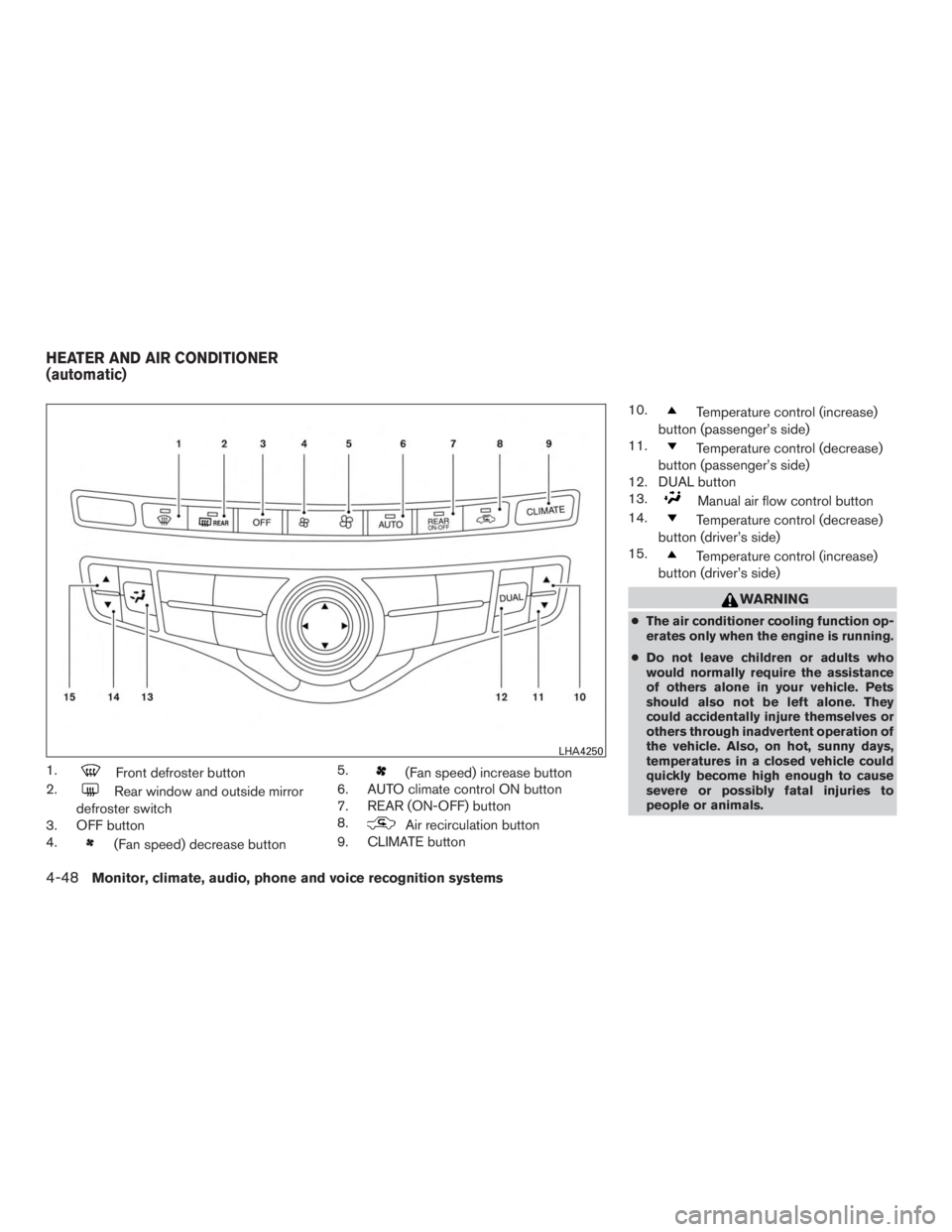
1.Front defroster button
2.
Rear window and outside mirror
defroster switch
3. OFF button
4.
(Fan speed) decrease button 5.
(Fan speed) increase button
6. AUTO climate control ON button
7. REAR (ON-OFF) button
8.
Air recirculation button
9. CLIMATE button 10.
Temperature control (increase)
button (passenger’s side)
11.
Temperature control (decrease)
button (passenger’s side)
12. DUAL button
13.
Manual air flow control button
14.
Temperature control (decrease)
button (driver’s side)
15.
Temperature control (increase)
button (driver’s side)
WARNING
● The air conditioner cooling function op-
erates only when the engine is running.
● Do not leave children or adults who
would normally require the assistance
of others alone in your vehicle. Pets
should also not be left alone. They
could accidentally injure themselves or
others through inadvertent operation of
the vehicle. Also, on hot, sunny days,
temperatures in a closed vehicle could
quickly become high enough to cause
severe or possibly fatal injuries to
people or animals.
LHA4250
HEATER AND AIR CONDITIONER
(automatic)
4-48Monitor, climate, audio, phone and voice recognition systems
Page 252 of 629
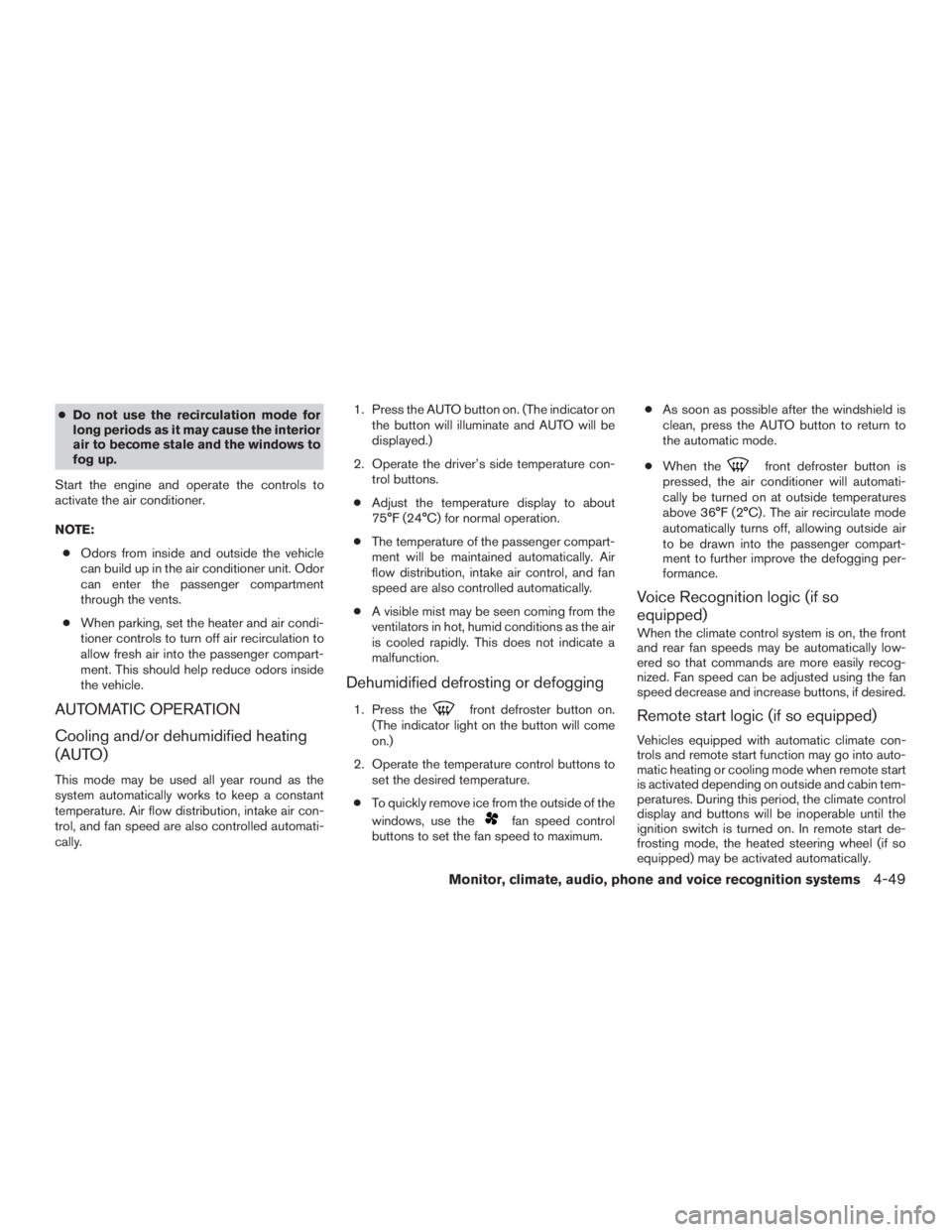
●Do not use the recirculation mode for
long periods as it may cause the interior
air to become stale and the windows to
fog up.
Start the engine and operate the controls to
activate the air conditioner.
NOTE: ● Odors from inside and outside the vehicle
can build up in the air conditioner unit. Odor
can enter the passenger compartment
through the vents.
● When parking, set the heater and air condi-
tioner controls to turn off air recirculation to
allow fresh air into the passenger compart-
ment. This should help reduce odors inside
the vehicle.
AUTOMATIC OPERATION
Cooling and/or dehumidified heating
(AUTO)
This mode may be used all year round as the
system automatically works to keep a constant
temperature. Air flow distribution, intake air con-
trol, and fan speed are also controlled automati-
cally. 1. Press the AUTO button on. (The indicator on
the button will illuminate and AUTO will be
displayed.)
2. Operate the driver’s side temperature con- trol buttons.
● Adjust the temperature display to about
75°F (24°C) for normal operation.
● The temperature of the passenger compart-
ment will be maintained automatically. Air
flow distribution, intake air control, and fan
speed are also controlled automatically.
● A visible mist may be seen coming from the
ventilators in hot, humid conditions as the air
is cooled rapidly. This does not indicate a
malfunction.
Dehumidified defrosting or defogging
1. Press thefront defroster button on.
(The indicator light on the button will come
on.)
2. Operate the temperature control buttons to set the desired temperature.
● To quickly remove ice from the outside of the
windows, use the
fan speed control
buttons to set the fan speed to maximum. ●
As soon as possible after the windshield is
clean, press the AUTO button to return to
the automatic mode.
● When the
front defroster button is
pressed, the air conditioner will automati-
cally be turned on at outside temperatures
above 36°F (2°C) . The air recirculate mode
automatically turns off, allowing outside air
to be drawn into the passenger compart-
ment to further improve the defogging per-
formance.
Voice Recognition logic (if so
equipped)
When the climate control system is on, the front
and rear fan speeds may be automatically low-
ered so that commands are more easily recog-
nized. Fan speed can be adjusted using the fan
speed decrease and increase buttons, if desired.
Remote start logic (if so equipped)
Vehicles equipped with automatic climate con-
trols and remote start function may go into auto-
matic heating or cooling mode when remote start
is activated depending on outside and cabin tem-
peratures. During this period, the climate control
display and buttons will be inoperable until the
ignition switch is turned on. In remote start de-
frosting mode, the heated steering wheel (if so
equipped) may be activated automatically.
Monitor, climate, audio, phone and voice recognition systems4-49
Page 253 of 629
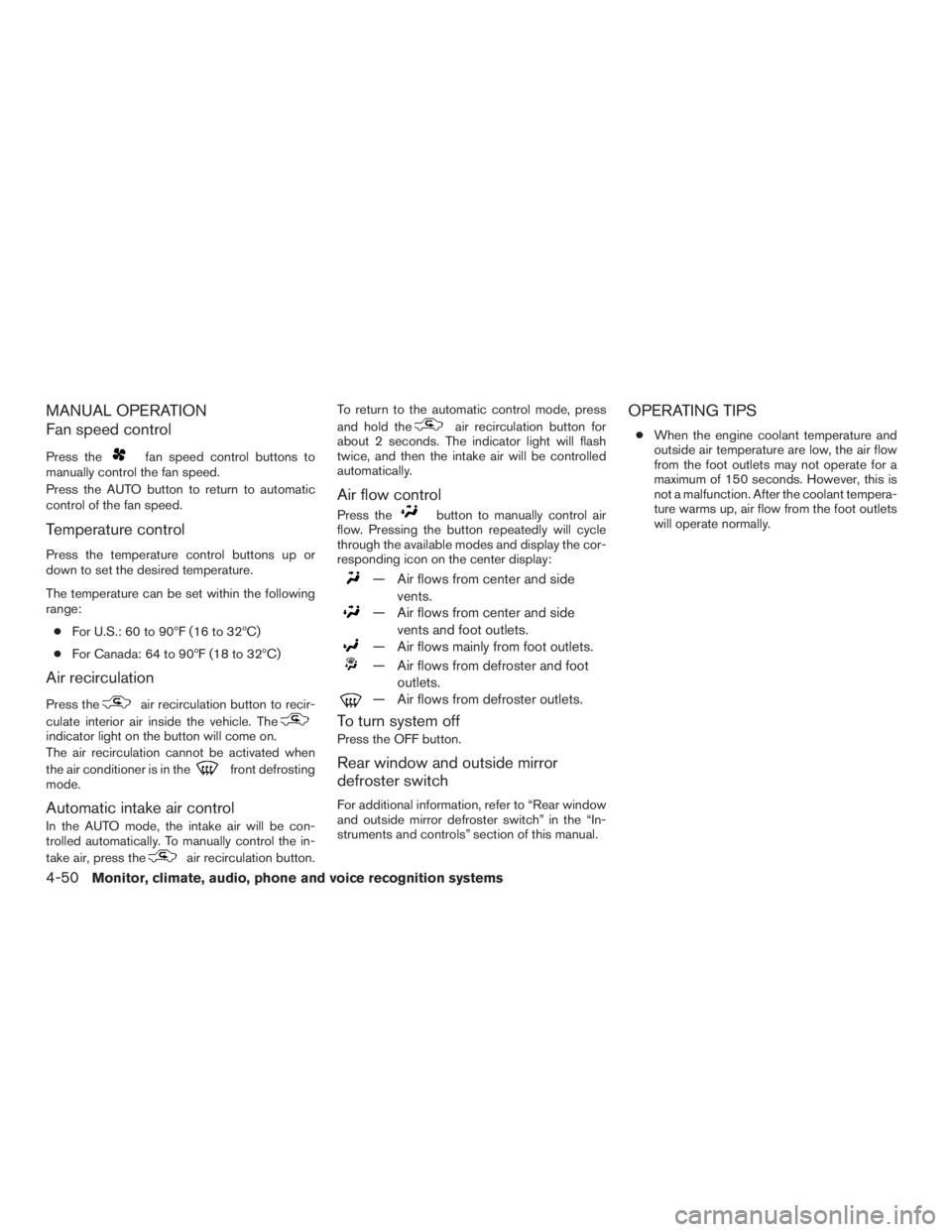
MANUAL OPERATION
Fan speed control
Press thefan speed control buttons to
manually control the fan speed.
Press the AUTO button to return to automatic
control of the fan speed.
Temperature control
Press the temperature control buttons up or
down to set the desired temperature.
The temperature can be set within the following
range:
● For U.S.: 60 to 90ºF (16 to 32ºC)
● For Canada: 64 to 90ºF (18 to 32ºC)
Air recirculation
Press theair recirculation button to recir-
culate interior air inside the vehicle. The
indicator light on the button will come on.
The air recirculation cannot be activated when
the air conditioner is in the
front defrosting
mode.
Automatic intake air control
In the AUTO mode, the intake air will be con-
trolled automatically. To manually control the in-
take air, press the
air recirculation button. To return to the automatic control mode, press
and hold the
air recirculation button for
about 2 seconds. The indicator light will flash
twice, and then the intake air will be controlled
automatically.
Air flow control
Press thebutton to manually control air
flow. Pressing the button repeatedly will cycle
through the available modes and display the cor-
responding icon on the center display:
— Air flows from center and side
vents.
— Air flows from center and sidevents and foot outlets.
— Air flows mainly from foot outlets.
— Air flows from defroster and footoutlets.
— Air flows from defroster outlets.
To turn system off
Press the OFF button.
Rear window and outside mirror
defroster switch
For additional information, refer to “Rear window
and outside mirror defroster switch” in the “In-
struments and controls” section of this manual.
OPERATING TIPS
●When the engine coolant temperature and
outside air temperature are low, the air flow
from the foot outlets may not operate for a
maximum of 150 seconds. However, this is
not a malfunction. After the coolant tempera-
ture warms up, air flow from the foot outlets
will operate normally.
4-50Monitor, climate, audio, phone and voice recognition systems
Page 254 of 629
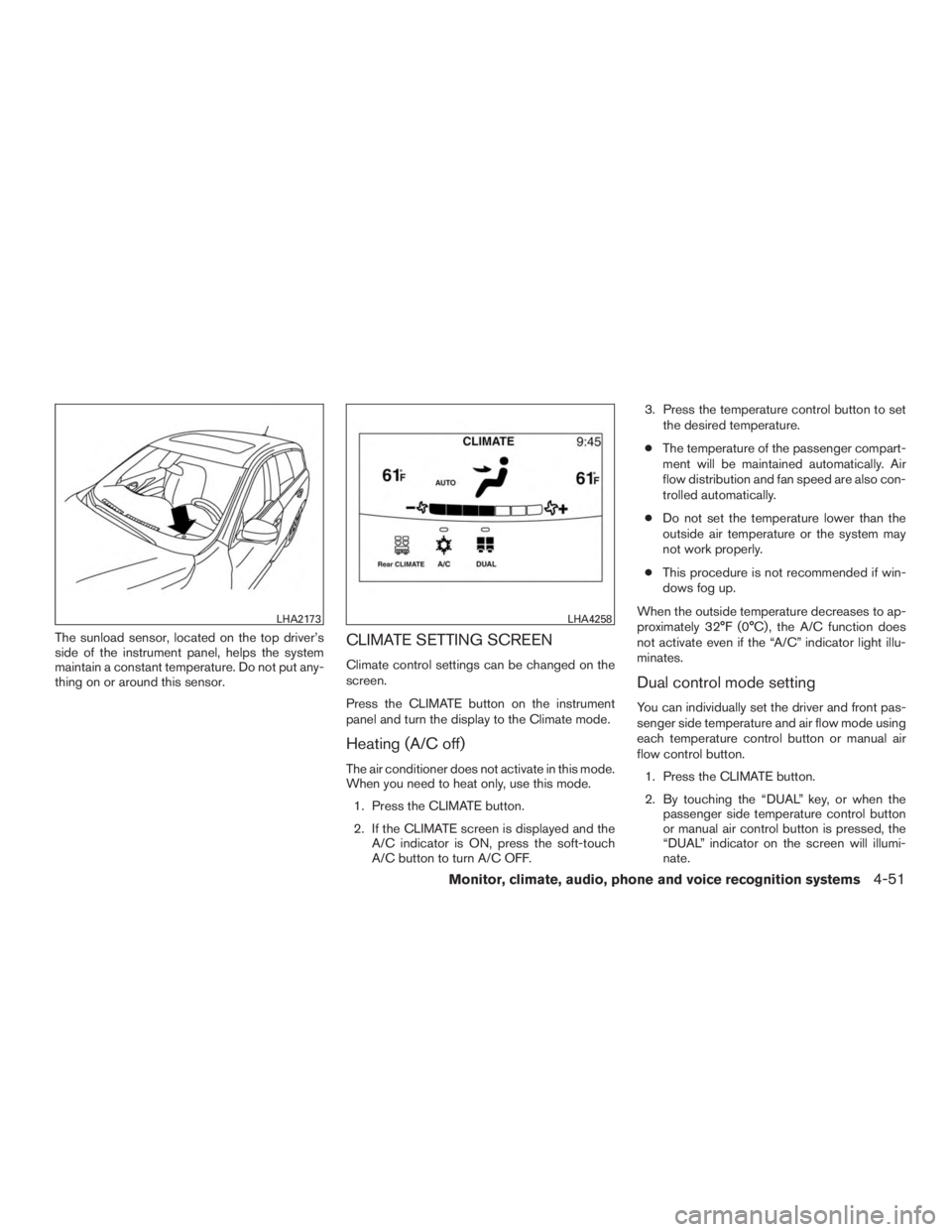
The sunload sensor, located on the top driver’s
side of the instrument panel, helps the system
maintain a constant temperature. Do not put any-
thing on or around this sensor.CLIMATE SETTING SCREEN
Climate control settings can be changed on the
screen.
Press the CLIMATE button on the instrument
panel and turn the display to the Climate mode.
Heating (A/C off)
The air conditioner does not activate in this mode.
When you need to heat only, use this mode.1. Press the CLIMATE button.
2. If the CLIMATE screen is displayed and the A/C indicator is ON, press the soft-touch
A/C button to turn A/C OFF. 3. Press the temperature control button to set
the desired temperature.
● The temperature of the passenger compart-
ment will be maintained automatically. Air
flow distribution and fan speed are also con-
trolled automatically.
● Do not set the temperature lower than the
outside air temperature or the system may
not work properly.
● This procedure is not recommended if win-
dows fog up.
When the outside temperature decreases to ap-
proximately 32°F (0°C) , the A/C function does
not activate even if the “A/C” indicator light illu-
minates.
Dual control mode setting
You can individually set the driver and front pas-
senger side temperature and air flow mode using
each temperature control button or manual air
flow control button. 1. Press the CLIMATE button.
2. By touching the “DUAL” key, or when the passenger side temperature control button
or manual air control button is pressed, the
“DUAL” indicator on the screen will illumi-
nate.
LHA2173LHA4258
Monitor, climate, audio, phone and voice recognition systems4-51
Page 255 of 629
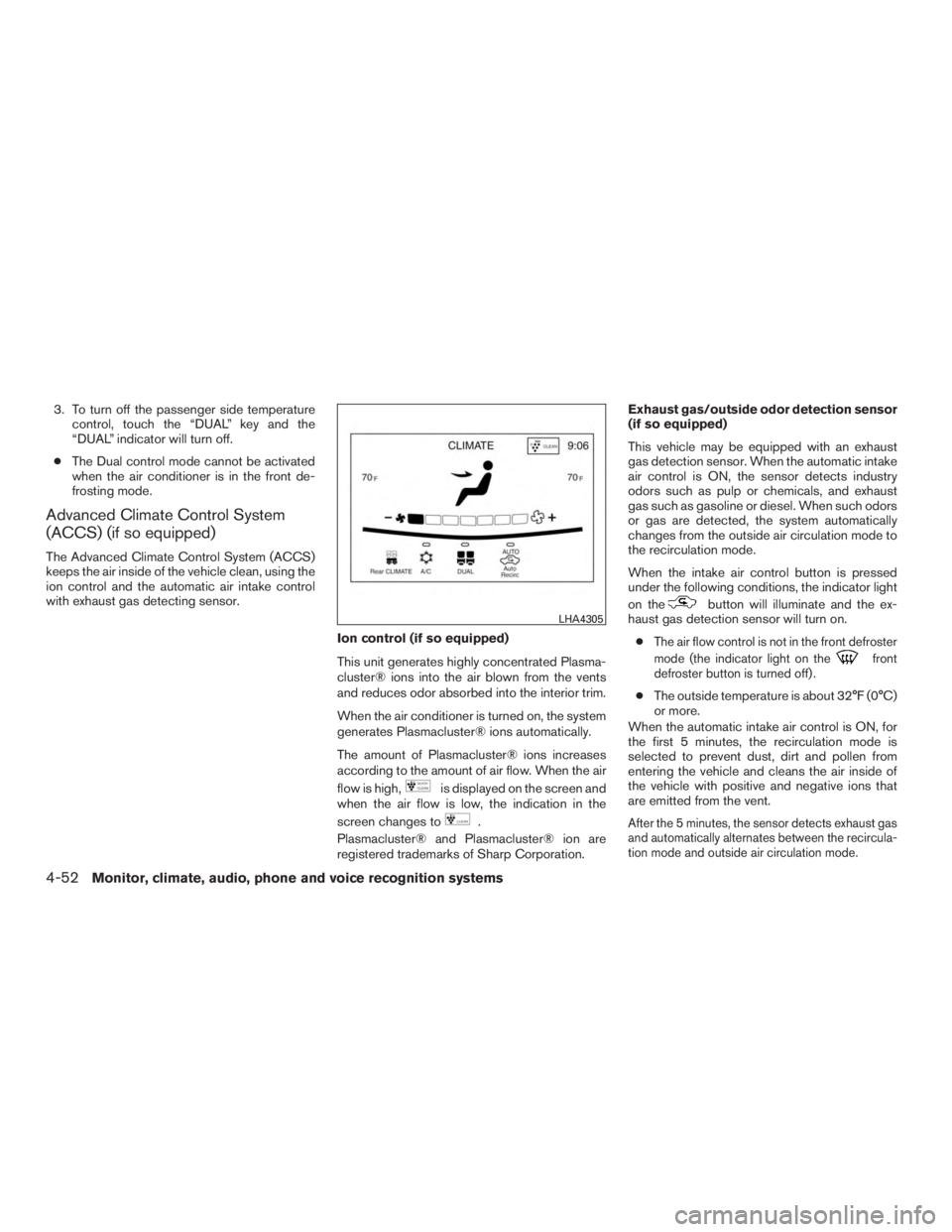
3. To turn off the passenger side temperaturecontrol, touch the “DUAL” key and the
“DUAL” indicator will turn off.
● The Dual control mode cannot be activated
when the air conditioner is in the front de-
frosting mode.
Advanced Climate Control System
(ACCS) (if so equipped)
The Advanced Climate Control System (ACCS)
keeps the air inside of the vehicle clean, using the
ion control and the automatic air intake control
with exhaust gas detecting sensor.
Ion control (if so equipped)
This unit generates highly concentrated Plasma-
cluster® ions into the air blown from the vents
and reduces odor absorbed into the interior trim.
When the air conditioner is turned on, the system
generates Plasmacluster® ions automatically.
The amount of Plasmacluster® ions increases
according to the amount of air flow. When the air
flow is high,
is displayed on the screen and
when the air flow is low, the indication in the
screen changes to
.
Plasmacluster® and Plasmacluster® ion are
registered trademarks of Sharp Corporation. Exhaust gas/outside odor detection sensor
(if so equipped)
This vehicle may be equipped with an exhaust
gas detection sensor. When the automatic intake
air control is ON, the sensor detects industry
odors such as pulp or chemicals, and exhaust
gas such as gasoline or diesel. When such odors
or gas are detected, the system automatically
changes from the outside air circulation mode to
the recirculation mode.
When the intake air control button is pressed
under the following conditions, the indicator light
on the
button will illuminate and the ex-
haust gas detection sensor will turn on.
●
The air flow control is not in the front defroster
mode (the indicator light on the
front
defroster button is turned off) .
● The outside temperature is about 32°F (0°C)
or more.
When the automatic intake air control is ON, for
the first 5 minutes, the recirculation mode is
selected to prevent dust, dirt and pollen from
entering the vehicle and cleans the air inside of
the vehicle with positive and negative ions that
are emitted from the vent.
After the 5 minutes, the sensor detects exhaust gas
and automatically alternates between the recircula-
tion mode and outside air circulation mode.
LHA4305
4-52Monitor, climate, audio, phone and voice recognition systems
Page 256 of 629

REAR AUTOMATIC AIR
CONDITIONING SYSTEM
1. OFF button2.
(fan speed) increase and decrease
buttons
3. AUTO button
4. REAR (ON-OFF) button 5. CLIMATE button
6.
(temperature) increase and decrease
buttons (driver’s side)
To turn on/off the rear automatic air conditioning
system with the front air conditioner control
panel, press the REAR (ON-OFF) button.
The rear automatic air conditioning system can
be adjusted with the front air conditioner control
panel when the Rear Climate screen is displayed.
To control the rear automatic air condition system
with the front air conditioner control panel, press
the CLIMATE button. When the display shows
front climate control, touch the Rear Climate key
on the screen.
Automatic operation
1. Press the AUTO button. The AUTO indicator light will illuminate in the Rear Climate dis-
play.
2. Press the temperature increase and de- crease buttons (driver’s side) to set the de-
sired temperature.
Front Controls
LHA4251
Monitor, climate, audio, phone and voice recognition systems4-53
Page 257 of 629
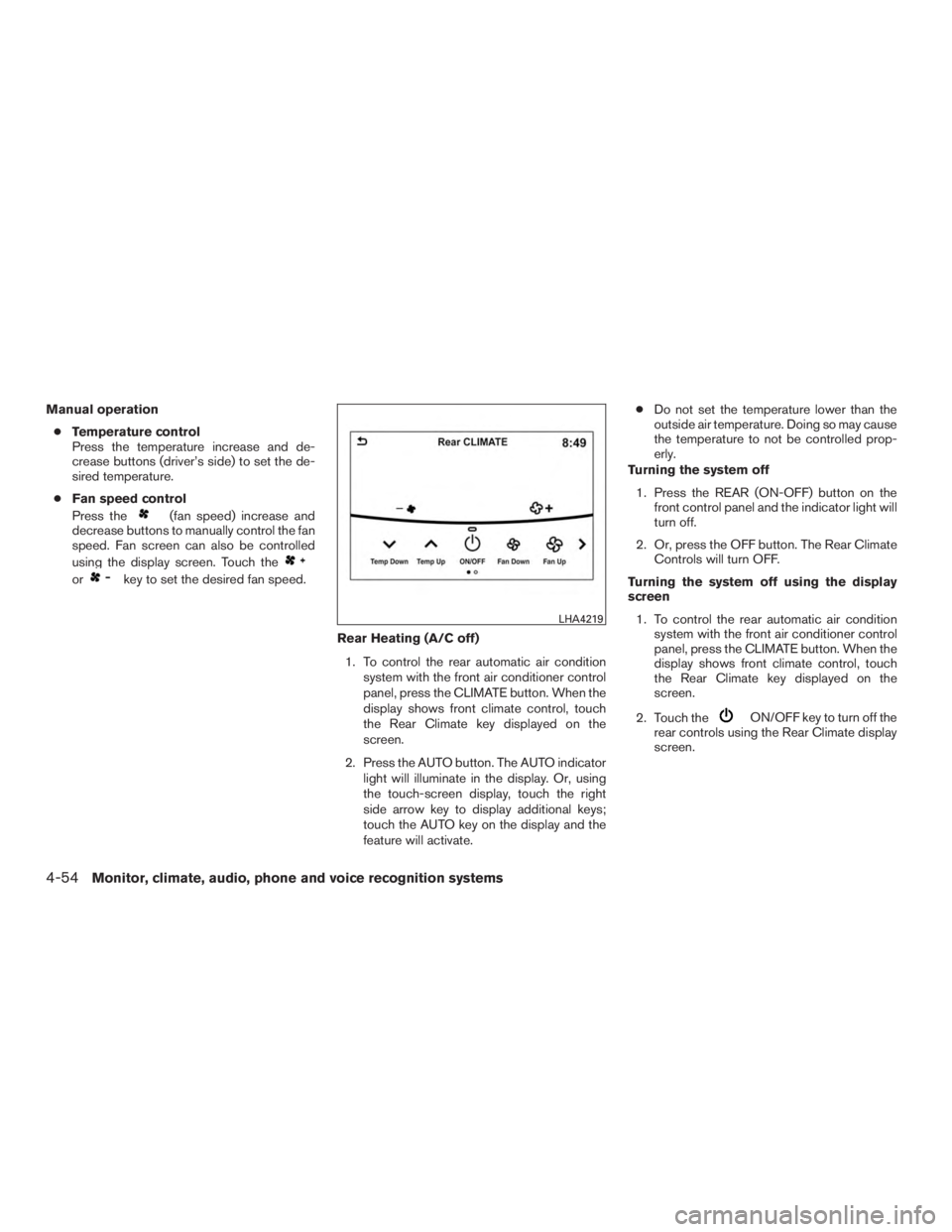
Manual operation● Temperature control
Press the temperature increase and de-
crease buttons (driver’s side) to set the de-
sired temperature.
● Fan speed control
Press the
(fan speed) increase and
decrease buttons to manually control the fan
speed. Fan screen can also be controlled
using the display screen. Touch the
orkey to set the desired fan speed.
Rear Heating (A/C off)1. To control the rear automatic air condition system with the front air conditioner control
panel, press the CLIMATE button. When the
display shows front climate control, touch
the Rear Climate key displayed on the
screen.
2. Press the AUTO button. The AUTO indicator light will illuminate in the display. Or, using
the touch-screen display, touch the right
side arrow key to display additional keys;
touch the AUTO key on the display and the
feature will activate. ●
Do not set the temperature lower than the
outside air temperature. Doing so may cause
the temperature to not be controlled prop-
erly.
Turning the system off
1. Press the REAR (ON-OFF) button on the front control panel and the indicator light will
turn off.
2. Or, press the OFF button. The Rear Climate Controls will turn OFF.
Turning the system off using the display
screen 1. To control the rear automatic air condition system with the front air conditioner control
panel, press the CLIMATE button. When the
display shows front climate control, touch
the Rear Climate key displayed on the
screen.
2. Touch the
ON/OFF key to turn off the
rear controls using the Rear Climate display
screen.
LHA4219
4-54Monitor, climate, audio, phone and voice recognition systems
Page 258 of 629

Rear control buttons1. OFF button
2.
(fan speed increase) button
3. AUTO button
4.
(temperature increase) button
5.
(temperature decrease) button
6. Display
7. — (fan speed decrease) button The rear seat passengers can adjust the rear
automatic air conditioning system using the con-
trol switches at the rear of the center console.
The rear control buttons do not function when the
Rear Climate screen is shown on the front dis-
play. To activate the rear control buttons, press
the CLIMATE button and the screen will return to
Front Climate control. This will enable the second
row Rear Climate controls.
● OFF button Turns rear automatic air condi-
tioning system off. ●
Fan speed increase and decrease but-
tons Adjusts the rear fan speed up or down.
● AUTO button Turns rear automatic air con-
ditioning system on, AUTO mode on.
● Temperature increase and decrease
buttons Adjusts the rear temperature up or
down.
Rear Controls
LHA2134
Monitor, climate, audio, phone and voice recognition systems4-55
Page 259 of 629
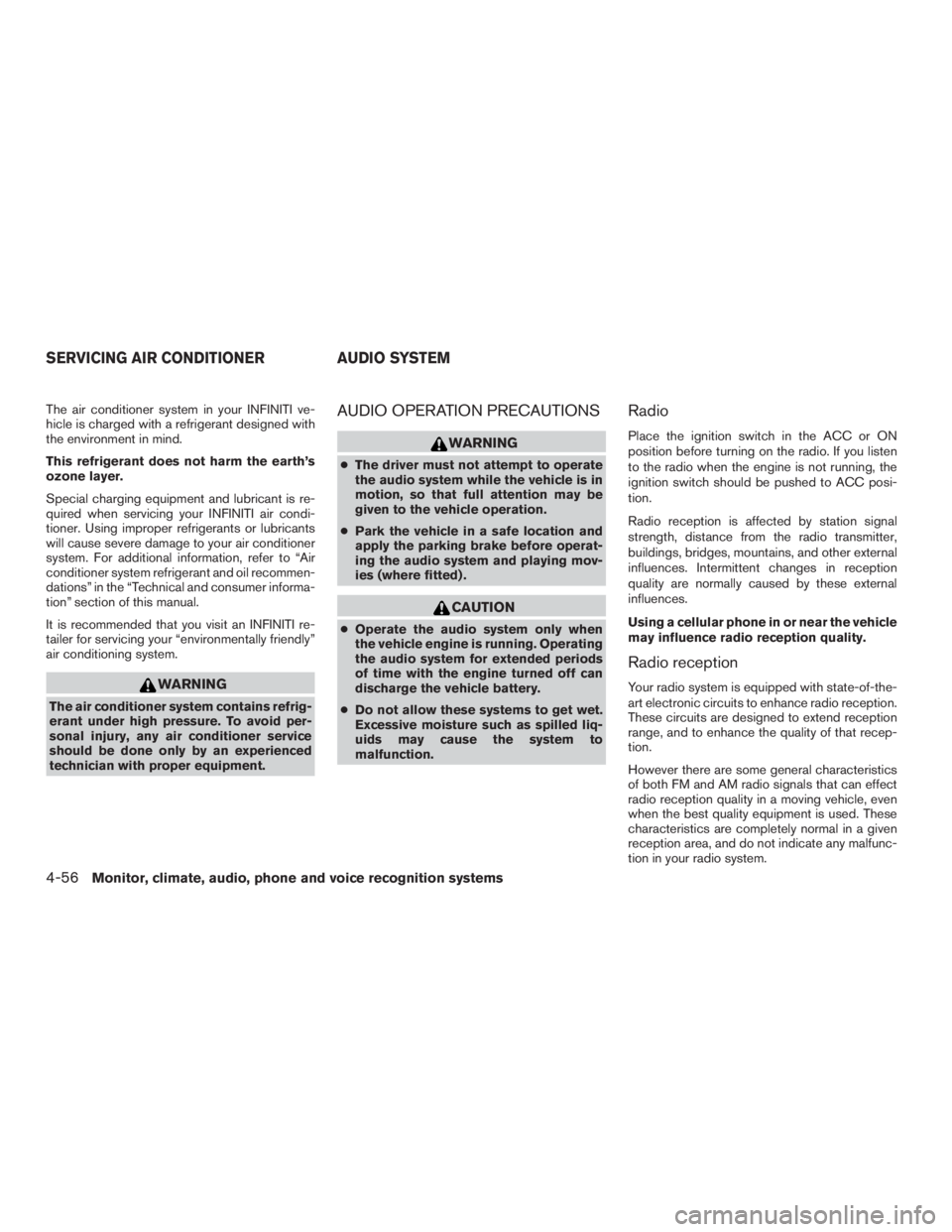
The air conditioner system in your INFINITI ve-
hicle is charged with a refrigerant designed with
the environment in mind.
This refrigerant does not harm the earth’s
ozone layer.
Special charging equipment and lubricant is re-
quired when servicing your INFINITI air condi-
tioner. Using improper refrigerants or lubricants
will cause severe damage to your air conditioner
system. For additional information, refer to “Air
conditioner system refrigerant and oil recommen-
dations” in the “Technical and consumer informa-
tion” section of this manual.
It is recommended that you visit an INFINITI re-
tailer for servicing your “environmentally friendly”
air conditioning system.
WARNING
The air conditioner system contains refrig-
erant under high pressure. To avoid per-
sonal injury, any air conditioner service
should be done only by an experienced
technician with proper equipment.
AUDIO OPERATION PRECAUTIONS
WARNING
●The driver must not attempt to operate
the audio system while the vehicle is in
motion, so that full attention may be
given to the vehicle operation.
● Park the vehicle in a safe location and
apply the parking brake before operat-
ing the audio system and playing mov-
ies (where fitted) .
CAUTION
●Operate the audio system only when
the vehicle engine is running. Operating
the audio system for extended periods
of time with the engine turned off can
discharge the vehicle battery.
● Do not allow these systems to get wet.
Excessive moisture such as spilled liq-
uids may cause the system to
malfunction.
Radio
Place the ignition switch in the ACC or ON
position before turning on the radio. If you listen
to the radio when the engine is not running, the
ignition switch should be pushed to ACC posi-
tion.
Radio reception is affected by station signal
strength, distance from the radio transmitter,
buildings, bridges, mountains, and other external
influences. Intermittent changes in reception
quality are normally caused by these external
influences.
Using a cellular phone in or near the vehicle
may influence radio reception quality.
Radio reception
Your radio system is equipped with state-of-the-
art electronic circuits to enhance radio reception.
These circuits are designed to extend reception
range, and to enhance the quality of that recep-
tion.
However there are some general characteristics
of both FM and AM radio signals that can effect
radio reception quality in a moving vehicle, even
when the best quality equipment is used. These
characteristics are completely normal in a given
reception area, and do not indicate any malfunc-
tion in your radio system.
SERVICING AIR CONDITIONER AUDIO SYSTEM
4-56Monitor, climate, audio, phone and voice recognition systems
Page 260 of 629

Reception conditions will constantly change be-
cause of vehicle movement. Buildings, terrain,
signal distance and interference from other ve-
hicles can adversely affect ideal reception. De-
scribed below are some of the factors that can
affect radio reception.
Some cellular phones or other devices may
cause interference or a buzzing noise to come
from the audio system speakers. Storing the de-
vice in a different location may reduce or elimi-
nate the noise.
FM radio reception
Maximum Signal Distances● FM: 25 to 30 miles (40 to 48 km)
● AM: 60 to 130 miles (97 to 209 km)
Range: FM range in normally limited to 25 to
30 miles (40 to 48 km) with monaural (single
station) FM having slightly more range than ste-
reo FM. External influences may sometimes inter-
fere with FM station reception even if the FM
station is within the 25 miles (40 km) . The
strength of the FM signal is directly related to the
distance between the transmitter and receiver.
FM signals follow a line-of-sight path, exhibiting many of the same characteristics as light. For
example they will reflect off objects.
Fade and drift: As your vehicle moves away from
a station transmitter, the signals will tend to fade
and/or drift.
Static and flutter: During signal interference from
buildings, large hills or due to antenna position,
usually in conjunction with an increased distance
from the station transmitter, static or flutter can
be heard. This can be reduced by lowering the
treble setting to reduce the treble response.
Multipath reception: Because of the reflective
characteristics of FM signals, direct and reflected
signals reach the receiver at the same time. The
signals may cancel each other, resulting in mo-
mentary flutter or loss of sound.AM radio reception
AM signals, because of their low frequency, can
bend around objects and skip along the ground.
In addition, the signals can bounce off the iono-
sphere and be bent back to earth. Because of
these characteristics, AM signals are also sub-
ject to interference as they travel from transmitter
to receiver.
SAA0306
Monitor, climate, audio, phone and voice recognition systems4-57